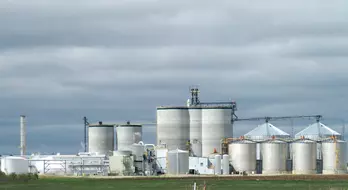U.S. Ethanol Manufacturers to Shift Their Focus Towards Sanitizer

The unique nature of the COVID-19 crisis proposed a new set of challenges and opportunities to various sectors of the U.S. economy and, most significantly, to the ethanol manufacturing sector. Earlier this year, in the months of April and May, ethanol manufacturers in the United States faced difficulty with their supply and demand chains.
With lower demand and supply in abundance, the ethanol manufacturers now plan to shift their focus on manufacturing high-grade alcohol for the purpose of making sanitizers. Red River, Pacific Ethanol PEIX.O, Green Plains GPRE.O, and Highwater Ethanol HEOL.PK are some companies that are planning to manufacture high-grade alcohol in the long run in order to generate revenue.
In the month of April 2020, a refinery in Grand Forks, North Dakota named Red River Biorefinery, an ethanol manufacturer, resumed its operations, arguably the worst time to begin operating as the COVID-19 pandemic worsened the demand for fuel. However, by observing the massive demand for sanitizers, the company switched its focus from producing fuel ethanol to producing high-grade alcohol for hand-sanitizers. This massive demand was created due to the panic caused by the COVID-19 outbreak about sanitation requirements among the U.S. citizens.
Since April 2020, Red River Biorefinery and many other U.S ethanol manufacturers are focusing their yield on high-grade alcohol instead of using ethanol for fuel by making permanent investments. The U.S.-based companies like Pacific Ethanol PEIX.O, Green Plains GPRE.O, and Highwater Ethanol HEOL.PK have said that they plan to boost their capacity for high-grade alcohol.
The reason given by the majority of the companies, who were purely inclined towards the fuel sector in the pre-COVID era, to shift their focus from fuel-grade ethanol to high-grade alcohol is the sudden shift in supply and demand and a promising case margin comparatively between fuel-grade ethanol and high-grade alcohol. The sudden shift of focus indicates that ethanol manufacturers see more profitability in hand hygiene because of the COVID-19 outbreak than in the production and transportation of fuels.
As of January 2020, the United States’ fuel ethanol production capacity has been estimated to go up to 17.4 billion gallons per year, which was higher than 2019’s 16.9 billion gallons per year. The fuel ethanol production nationwide has risen after plummeting from 537,000 barrels per day in April 2020 to 923,000 barrels per day.
The shift of focus from fuel ethanol to high-grade alcohol has brought some positive changes for the ethanol manufacturers. Red River, with its expansion in its output for USP-grade alcohol used for sanitizers, has added loadout equipment and a tank farm in order to facilitate the increasing output, which was just under a million gallons per month. Additionally, the U.S. Corn Belt ethanol margins ETH-CB-REF have also recovered to 9 cents per gallon from April’s low of -22 cents, but they remain half of the previous year’s levels.
Pacific Ethanol Inc., a Sacramento-based producer and marketer of low-carbon renewable fuels, also reported positive and strong second-quarter results in August 2020 due to favourable margins being created by high-grade alcohol. Aemetis Inc, an advanced renewable fuels and biochemicals company, has also recently announced its recent commencement of the production of hand sanitizer under its subsidiary named Aemetis Health Products. In late August 2020, an ethanol-producing plant, Global Impact Innovation, Galva, IL, also shifted its production solely towards hand-sanitizer, with a goal of making 60,000 gallons per week.
With an increasing demand for sanitisation products such as hand sanitizers, alcohol-containing tissues, disinfectant rubs, and more, the companies shifting from fuel-grade ethanol to high-grade alcohol for a longer haul has proven to be positively impactful till now.
This massive shift has brought positive feedbacks such as increased revenue generation, usage of pre-stocked chemical (ethanol), and increased shares. With no future estimates of COVID-19’s presence across the nation and a mass panic among the U.S citizens, the demand for hand sanitizer will remain promising.



